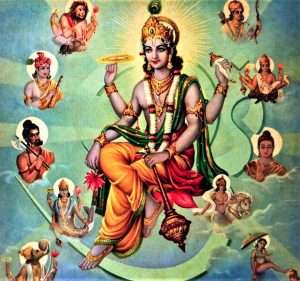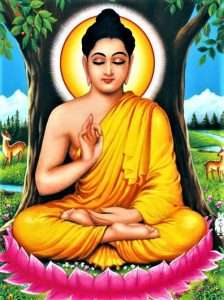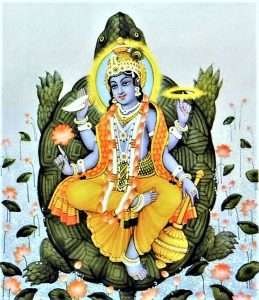God and His incarnations (Avataravada)
God and His incarnation is acknowledged in broad details in Hinduism. In other faiths as well, there are discussions about prophets who carried the message of God. In this way, the talks about an entity with very special capabilities is known to all faiths of the world. In Hinduism, this topic has very important explanations. It says that God descends on earth or wherever He wishes so as a human or in any other form He may deem necessary for a certain purpose known only to Him. This descent is called God’s incarnation.

Avatar (Manifestation or Incarnation of God) – The Sanskrit word “Avatar” means descendance. In Hinduism, there is a description that God descends on earth or on whichever planes of existence He wishes so. The avatar of God happens to carry out some specific purposes. The Bhagavad Gita (4.7,8,9) explains this approach towards God’s incarnation. It says –
Sanskrit –
यदा यदा हि धर्मस्य ग्लानिर्भवति भारत|
अभ्युत्थानमधर्मस्य तदात्मानं सृजाम्यहम्|| 7||
Transliteration –
Yada yada hi dharmasya glanir bhavati bharata|
Abhyutthanam adharmasya tadatmanam srijamyaham||7||
Translation –
O Arjuna! Whenever there is a decline in righteousness and an increase in unrighteousness, then I incarnate Myself.
Sanskrit –
परित्राणाय साधूनां विनाशाय च दुष्कृताम्|
धर्मसंस्थापनार्थाय सम्भवामि युगे युगे|| 8||
Transliteration –
Paritranaya sadhunam vinashaya cha dushkritam|
Dharma samsthapanarthaya sambhavami yuge yuge||8||

Translation –
In order to protect the righteous, to annihilate the unrighteous and to reinstate the dharma (virtue), I manifest Myself, age after age.
Sanskrit –
जन्म कर्म च मे दिव्यमेवं यो वेत्ति तत्त्वत:|
त्यक्त्वा देहं पुनर्जन्म नैति मामेति सोऽर्जुन|| 9||
Transliteration –
Janma karma cha me divyam evam yo vetti tattvatah|
Tyaktva deham punar janma naiti mameti sorjuna||9||
Translation –
O Arjuna! Those who know this divine nature of My birth and sports, are not reborn after death but come to Me.
The proposition in the Gita has been verified by the verses in the Srimad Bhagavatam (1.3.26, 27, 28). It says –
Sanskrit –
अवतारा ह्यसङ्ख्येया हरे: सत्त्वनिधेर्द्विजा:|
यथाविदासिन: कुल्या: सरस: स्यु: सहस्रश:||26||
Transliteration –

Avatara hyasankhyeya hareh sattvanidher dvijah|
Yathavidasinah kulyah sarasah syuh sahasrasah||26||
Translation –
O Brahmaṇas, the incarnations of God are innumerable, like thousands of rivulets flowing from inexhaustible sources of vast lakes.
Sanskrit –
ऋषयो मनवो देवा मनुपुत्रा महौजस:|
कला: सर्वे हरेरेव सप्रजापतय: स्मृता:||27||
Transliteration –
Risayo manavo deva manuputra mahaujasah|
Kalah sarve harereva saprajapatayah smrtah||27||
Translation –
All the rishi (saints), all Manu (celestial kings), demigods and descendants of Manu, including all the Prajapati (a special level of celestial kings), who are especially powerful, are but plenary portions or portions of the plenary portions of God.
The Srimad Bhagavatam (1.3.27) is very similar to the Gita (10.41,42).
Sanskrit –

एते चांशकला: पुंस: कृष्णस्तु भगवान् स्वयम्|
इन्द्रारिव्याकुलं लोकं मृडयन्ति युगे युगे||28||
Transliteration –
Ete chamsa kalah pumsah Krishastu bhagavan svayam|
Indrarivyakulam lokam mrodayanti yuge yuge||28||
Translation –
All the above-mentioned incarnations are either plenary portions or portions of the plenary portions of God but God Krishna is the greatest Godhead. Whenever there is a disorder created by the unrighteous, God manifests age after age.
The Srimad Bhagavatam (1.3.28) is very similar to the Gita (4.7).
The above scriptural references agree to a conclusion that God exists and God incarnates or manifests according to His own decisions; however, the common situations referred to are – the prevalence of unrighteousness, the reestablishment of righteousness, the protection of the righteous and the annihilation of the unrighteousness age after age which means at any point of time. When such a descension of God happens, then that is called the “Avatar”.
Kinds of Avatar – The ancient scriptures of Hinduism details different kinds of God’s incarnations. These various incarnations of God displayed different potentials during the time they happened. According to the manifestation of God’s infinite potential, the Avatar of God has been classified. In the Garga Samhita (Goloka Khanda, 1.1.16), the great sage Narada says –
Sanskrit –
श्रीनारद उवाच –

अंशांशोंऽशस्तथावेशः कलापूर्णः प्रकथ्यते|
व्यासाद्यैश्च स्मृतः षष्ठः परिपूर्णतमः स्वयम्||16||
Transliteration –
Sri Narada uvacha –
Ansansonsas tathavesah kala purnah prakathyate|
Vyasyadyaischa smritah sasthah paripurnatamah svayam||16||
Narada said – In the Smriti Shastra (a kind of scripture in Hinduism), the chief among the saints Veda Vyasa explains that God incarnates in six different levels –
- Anshansha (a part of a part)
- Ansha (a part)
- Avesha (charged; entrance into an individual soul)
- Kala (a full part)
- Purna (full)
- Paripurnatam (the most full)
Uniqueness of God’s Avatar – In different scriptures of Hinduism such as Narada Pancharatra, Srimad Bhagavatam and so on, even other different levels of God’s incarnation have been explained. This simply means that God’s manifestation has varied aspects and it is always for a specific universal purpose. Each incarnation of God is unique. The different kinds of God’s incarnation does not mean that any one Avatar is bigger than the others. In a certain Avatar, God displays certain attributes than other Avatar. This is always according to the will of God and the needs of the present situation. In a particular incarnation, the residuary powers of God remain latent than the manifested powers which is why we misunderstand that certain Avatar of God is smaller or bigger. But in essence each incarnation of God is equally potent and full. In certain scripture a certain Avatar or form of God is highly praised and recognised as higher than others. This higher praise of the particular incarnation or form of God is to develop and strengthen the feelings of the devotee towards that incarnation or form of God.
Important Avatar of God in Hinduism – In Hinduism, there are discussions of God’s many incarnations in different ages. Mainly in the Purana, this has been described in detail. The most important of them are the ten incarnations revered as the “Dashavatar”. In the greatest Purana, Srimad Bhagavatam, twenty four incarnations of God including the Dashavatar and others have been described as well. At the same time, it has been said that there are thousands of God’s incarnations. The ten most important God’s incarnations are –

Dashavatar (ten incarnations) –
- Matsya (Fish)
- Kurma (Tortoise)
- Varaha (Pig)
- Narasimha (Head of a Lion and body of a man)
- Vamana (Dwarf Human)
- Parashuram (The Ram who wields an axe)
- Ram (A human with a special bow and arrow)
- Krishna (A human with divine flute and magical disc)
- Buddha (A human with shrewd logic)
- Kalki (The future incarnation who will ride on a magical white horse with a divine sword in hand)
The additional incarnations are –
- Sanak
- Sanandan
- Sanatan
- Sanatkumar
- Narada
- Nara Narayana
- Kapila
- Dattatreya
- Yajna
- Rishabha
- Prithu
- Dhanvantri
- Mohini
- Hayagreeva
- Vyasa

God’s Avatar in other parts of the world – God’s incarnation is not limited to Bharat (India) only. The whole world and the entire universe is His God’s creation and He may manifest anywhere for any purpose to fulfil. Therefore, God’s incarnations happened also in other parts of the world. Some of those incarnations are –
- David
- Abraham
- Moses
- John the Baptist
- Jesus Christ
- Mohammad
- Zoroaster
People in different faiths relate to God differently and build up their own ideas of God which does not change the real identity of God. The one God in different forms displays His valor in different parts of the universe. God Krishna says in the Gita (10.41) –
Sanskrit –

यद्यद्विभूतिमत्सत्त्वं श्रीमदूर्जितमेव वा|
तत्देवावगच्छ त्वं मम तेजोंऽशसम्भवम्|| 41||
Transliteration –
Yad yad vibhuti matsattvam srimad urjitam eva va|
Tat tadavava gacchatvam mama tejonsa sambhavam||41||
Translation –
Whatever beings have powers, beauty, piety and energy – know such manifestations coming from a spark of My power.
Therefore, in any part of the world if anyone displays and executes extraordinary powers and capacities, He is indeed a direct representative of the powers of Almighty God. Such a being is always rare in the world but from time to time such beings appear for a greater cause.
Eternal devotees of God and their Avatar – There are some eternal devotees of God who are considered the greatest among all the devotees. Whenever God incarnates then they also incarnate to fulfil God’s divine purpose. They associate with God in His mission and spread God’s message as they have special abilities to receive God’s powers and share with other deserving people. The Srimad Bhagavatam (6.3.20,21) during a conversation between God of death (Dharmaraj/Yamraj) and His messengers (Yamduta), mentions the name of twelve intimate devotees of God who know all the secrets of divinity and incarnate when God incarnates for a higher cause. It says –

Sanskrit –
स्वयम्भूर्नारद: शम्भु: कुमार: कपिलो मनु:|
प्रह्लादो जनको भीष्मो बलिर्वैयासकिर्वयम्||20||
द्वादशैते विजानीमो धर्मं भागवतं भटा:|
गुह्यं विशुद्धं दुर्बोधं यं ज्ञात्वामृतमश्नुते||21||
Transliteration –
Svayambhur naradah sambhuh kumarah kapilo manuh|
Prahlado janako bhismo balir vaiyasakirvayam||20||
Dvadasaite vijanimo dharmam bhagavatam bhatah|
Guhyam visuddham durbodham yam jnatvamrtam asnute||21||
Translation –
God Brahma, Sage Narada, God Shiva, the four Kumar (Sanak, Sanandan, Sanatan, Sanatkumar), God Kapila, Svayambhuva Manu, Prahlada, Janaka, Bhisma, Bali, Shukadev and I myself (Dharmaraj/Yamraj) know the essence of religious principles. My dear servants, the “Bhagavata-dharma” (transcendental religious principle which is surrender to God and love for God) is untainted, very confidential and very difficult to understand, but if someone understands it then he is instantly liberated.

It is not necessary that all twelve intimate devotees of God must be born always and at the same time. But there are some occasions when all twelve devotees come together at different places and join the divine sports of God. When God incarnated as Jesus Christ then He had twelve disciples. The great saint Swami Ramananda (an incarnation of God) was born in Bharat then He also had twelve disciples who were the incarnations of the twelve intimate devotees of God. The great saint of the twentieth century, Ramakrishna Paramhamsa (mentioned in the Gospel of Ramakrishna) declared Himself as an incarnation of God. He would speak about the twelve intimate devotees of God to His close disciples. He often said that some of His disciples were devotees of Jesus, Chaitanya Mahaprabhu and other incarnations of God in their previous lives and they were reborn to join Him in His divine mission. Each incarnation of God is always surrounded by some intimate disciples who look after that God’s incarnations’ mission and truly understand the message of God’s incarnation.
Additionally, at the time of God’s incarnation, the enlightened soul, soul with deep longing for liberation (Mumukshu) and soul with their last possible birth are also born. They join God’s divine sports, participate in God’s divine work and attain liberation by God’s grace. In every incarnation, God grants liberation to many deserving souls as an incarnation of God He is always capable of granting liberation. Although this is a rare occasion. Ramakrishna Paramhamsa used to say to His close disciples that in every incarnation God expiates and elevates at least one utmost sinner such as Buddha liberated Angulimal, Chaitanya Mahaprabhu elevated Jagai and Madhai, Ramakrishma Paramhamsa elevated Girish Ghosh and so on. When an incarnation of God comes, then there comes a flood and storm of devotion, wisdom, unselfishness and all kinds of virtues. At the time even those who do not maintain sufficient discipline of life attain liberation as this is the time period of special grace. The incarnation of God is such a special event but this takes place on special occasions only for the welfare of entire universe and its beings.
Conclusion – According to holy scriptures of different faiths in the world, God and His incarnations are true. The whole world is God’s creation and His will operates everywhere. God is not limited by any law or cause. He is eternally unborn, invisible, everywhere and free and He manifests as well according to His well wherever He wills so and whichever form He deems necessary. It’s all a matter of belief and for some fortunate people this becomes a living experience as well.
With Love and Gratefulness (Founder Rohit Kumar)
Source – Srimad Bhagavatam, Gita, words of Ramakrishna Paramhamsa, Swami Sivananda, internet resources and personal study.
Hari Om Tat Sat!















